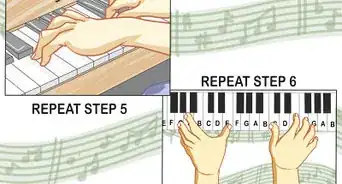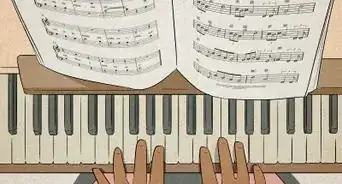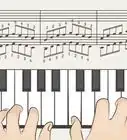This article was co-authored by Michael Noble, PhD and by wikiHow staff writer, Eric McClure. Michael Noble is a professional concert pianist who received his PhD in Piano Performance from the Yale School of Music. He is a previous contemporary music fellow of the Belgian American Educational Foundation and has performed at Carnegie Hall and at other venues across the United States, Europe, and Asia.
There are 11 references cited in this article, which can be found at the bottom of the page.
wikiHow marks an article as reader-approved once it receives enough positive feedback. This article received 26 testimonials and 85% of readers who voted found it helpful, earning it our reader-approved status.
This article has been viewed 1,642,223 times.
Learning the notes on a keyboard is an essential step towards learning how to play the piano, organ, or MIDI controller. While the shape and order of the notes on a keyboard are always the same, it can take some time to memorize and master them. After you’ve learned where to find notes on the keys, you can start to learn sheet music and practice playing the scales fluidly.
Steps
Identifying the Keys on the Keyboard
-
1Learn the order of the white keys by finding C. The first note in a scale is the C note. The order of the scale is C, D, E, F, G, A, and B, with the same pattern repeating after B. You can find the C key on a keyboard by looking for any pair of black keys that are surrounded on both sides by two white keys instead of one. C is always the key immediately to the left of the black key on the left side of that pair.[1]
- Note the pattern of white keys: three white keys enclosing two black keys, and four white keys enclosing three black keys. C is the white key on the left of the two enclosed black keys.
- This pattern is consistent on all keyboards. Every note on the keyboard is represented in this single 12-note octave, which is the term for an interval of notes that appear in the same order. Different octaves are higher or lower in pitch depending on where they are positioned in reference to the middle octave.
-
2Get familiar with the black keys by finding C♯/D♭. Each black key has two possible notes based on the context of the music that you’re playing. For example, C sharp (C♯) and D flat (D♭) are the same key on the piano, but the note changes whether you’re moving up or down on the keyboard, or whether or not you’re pressing a pedal. This is because the sound created by the black keys is imperfect, and doesn’t correspond perfectly with the natural scale. The black keys usually play a supporting role in most compositions, so it will help to remember their order by starting directly above the white C note in the middle, which is C♯ or D♭.[2]
- The symbol ♯ is read as “sharp,”[3] and the symbol ♭ is read as “flat.”
- The white keys are called “natural” tones, and are the main keys used in most songs. The black keys are known as “accidentals,” and contain sharp and flat sounds in tones in between the natural keys.
Black Key Labels
The 1st black key in the group is C♯ or D♭.
The 2nd black key in the group is D♯ or E♭.
The 3rd black key in the group is F♯ or G♭.
The 4th black key in the group is G♯ or A♭.
The 5th black key in the group is A♯ or B♭.
Advertisement -
3Familiarize yourself with the octaves on your keyboard. Going from left to right, every group of notes between a C and B is called an octave. A standard 88-key piano has 12.5 octaves. A note determines the tone of a key, while the octave determines the pitch. The notes on the left are lower in pitch, while the notes on your right will be higher. You almost always start playing a song from middle C, which is a term for the octave in the dead center of your piano.
- A grand or upright piano has 88 keys, but there are electronic and modified keyboards with 44 or 49 keys. The more keys that a keyboard has, the more octaves the keyboard is capable of playing.[4]
Interpreting Notation
-
1Learn how to interpret notation by understanding the staff. The staff refers to the 5 horizontal lines where musical notes are written. They are used to represent the letters of the scale visually, with the 4 spaces in between representing every other letter. The order of the notes changes based on whether the staff is in treble or bass.[5]
- On a treble clef, the note directly on the bottom line is E, and the note in between the first and second line is F. The note directly on top of the second line is A, and the note in between the second and third line is B. The pattern continues from there.
- On a bass clef, the note on the bottom line is G, and the note in between the first and second line is A. The note sitting directly on top of the second line is B, with the C note in between the second and third line. The pattern continues as you move up the scale.
-
2Start by learning the treble clef before learning the bass clef. The treble clef (or G clef) is the symbol that looks like a curly “6” with a line running through the center of it. It indicates what the notes in the following staff are. On a keyboard, the treble clef is used to indicate what the right hand is doing, while the bass clef is used to illustrate the left hand’s notes.[6]
- Start by learning the treble clef first, since the right hand is typically required to play most of the notes in beginner or intermediate sheet music.
- The treble scale starts with E at the bottom of the staff, while the bass scale starts with G at the bottom of the staff.
Fun Fact: Some instruments rely on other clefs. The alto clef is used with violas and trombones. The tenor clef is used with the bassoon and cello.[7]
-
3Distinguish between full notes, half notes, and quarter notes. A full note is a hollow circle with no bar sticking out of it and indicates that a key is meant to be played for the full duration of the note. A half note is hollow in the middle as well, but it has a vertical bar to indicate that the key should be pressed for half of a full note’s duration. A quarter note is the most common note and has a solid black circle with a vertical bar. It is a quarter length of a full note when you press it on the piano.[8]
- A flat line sitting on top of a staff line indicates a rest, which is where you don’t play anything for the duration of the measure.[9]
-
4Read chords by looking at notes that are stacked on top of one another. In sheet music, a chord is represented by multiple notes occupying the same vertical space at the same time. These notes are meant to be played together at the exact same time, almost always for the same duration. The duration is based on a song’s time signature, which tells you how many beats are in a given measure. Major and minor chords can radically change the mood of a piece of music, and will be essential to learn if you want to start songwriting.[10]
- The two numbers directly to the right of the clef are called the time signature. They tell you how quickly you’re supposed to play the notes based on the song’s tempo.[11]
- Major chords are chords that start in C, while minor chords start in E.
Memorizing the Keys
-
1Put a piece of tape on each key in the middle octave and label the keys. Take a piece of adhesive or electrical tape and put it on the pad for the C note in the middle octave. Write “C” on this key with a permanent marker, and repeat this process for each note on the middle chord. Label each note according to the letter used to represent it. Use this chord as a reference as you learn and memorize each of the notes on the scale.[12]
Tip: Use tape with a texture that you can instantly recognize so that you don’t need to look at the keys to find your scale.
-
2Use mnemonic devices to remember the order of notes. On a treble clef, the notes that rest directly on the lines in the staff are E, G, B, D, F. You can remember them easily by memorizing the phrase “Every Good Boy Does Fine.” The notes in between the lines are F, A, C, E, so you can memorize the word “face” to remember the order.[13]
- On a bass clef, the order of the keys translates easily to the phrase “Good Boys Do Fine Always” for the notes on the lines, and “All Cows Eat Grass” for the notes in between.[14]
-
3Train your ears to identify notes by matching sounds to a key. You can train your ears to register the resonance and tone of each note over time. To do this, select a key in the middle octave and hold it down. While the sound is playing, start humming the tune of the note. Try to match the note exactly. Repeat this process over the course of several practice sessions and you’ll find yourself identifying notes by sound alone, which will help you get better at hearing mistakes when you make them in practice.[15]
- This is a good way to internalize the sound of notes and will come in handy when you eventually want to picture what sheet music sounds like in your head.
-
4Translate the notes into muscle memory by practicing. The more you practice moving your fingers between notes and reading sheet music, the easier it will become. Practice your scales regularly– ideally every day– by playing the notes in order, one after the other, with both hands. This will help you memorize the sounds and get used to the feeling of each key under your fingers.[16]
- Start by practicing scales slowly and focusing on your finger positions. As you get more comfortable, do your scales faster and faster.
A useful practice exercise: Sit with your back straight and place your right thumb on middle C. Play the next 5 notes, D, E, F, G, A, and B, in order using each finger on your hand. Practice doing this as quickly as possible, then try doing the same thing with your left hand. This will help your fingers get used to the movements required to make the sound of each note.[17]
Community Q&A
-
QuestionHow are the chords arranged on the keyboard?
 Community AnswerBetween 3 white keys, there are 2 black keys. If there are 4 white keys, there wil lbe 3 black keys between them.
Community AnswerBetween 3 white keys, there are 2 black keys. If there are 4 white keys, there wil lbe 3 black keys between them. -
QuestionHow do I play (for example) Am?
 Community AnswerTo play it with your left hand, put your pinkie on A, your middle finger on C, and your thumb on E. Play these three notes. To play it with your right hand, put your thumb on A, your middle finger on C, and your pinkie on E.
Community AnswerTo play it with your left hand, put your pinkie on A, your middle finger on C, and your thumb on E. Play these three notes. To play it with your right hand, put your thumb on A, your middle finger on C, and your pinkie on E. -
QuestionHow do I play sharps and flats?
 Community AnswerSharps are one semitone higher (the very next note up, generally a black key except for e sharp and b sharp), and flats are one semitone lower (the very next note down; generally a black key except for f flat and c flat).
Community AnswerSharps are one semitone higher (the very next note up, generally a black key except for e sharp and b sharp), and flats are one semitone lower (the very next note down; generally a black key except for f flat and c flat).
References
- ↑ https://www.pianoscales.org/the-keyboard.html
- ↑ https://www.pianoscales.org/the-keyboard.html
- ↑ http://www.piano-keyboard-guide.com/piano-notes.html
- ↑ https://www.pianoscales.org/the-keyboard.html
- ↑ https://method-behind-the-music.com/theory/notation/
- ↑ https://www.musicnotes.com/now/tips/a-complete-guide-to-musical-clefs-what-are-they-and-how-to-use-them/
- ↑ https://www.musicnotes.com/now/tips/a-complete-guide-to-musical-clefs-what-are-they-and-how-to-use-them/
- ↑ https://blog.sheetmusicplus.com/2016/03/02/learn-how-to-read-sheet-music-rhythms/
- ↑ https://blog.sheetmusicplus.com/2016/03/02/learn-how-to-read-sheet-music-rhythms/
- ↑ https://www.musicnotes.com/now/tips/a-complete-guide-to-chord-symbols-in-music/
- ↑ https://www.musicnotes.com/now/tips/a-complete-guide-to-chord-symbols-in-music/
- ↑ https://www.youtube.com/watch?v=ovM0_74zoLw
- ↑ https://www.musicnotes.com/now/tips/how-to-read-sheet-music/
- ↑ https://www.joytunes.com/blog/music-fun/best-way-memorize-piano-notes/
- ↑ https://www.key-notes.com/blog/ear-training
- ↑ https://www.joytunes.com/blog/music-fun/best-way-memorize-piano-notes/
- ↑ https://youtu.be/tQh3-WBzaKY?t=75
About This Article
To learn the notes on a keyboard, find a set of 3 white keys enclosing 2 black keys, followed by 4 white keys enclosing 3 black keys. This pattern is consistent for all keyboards. The first white key in the set is the C key, and the next white key is D, then E, F, G, followed by A, B, and C again. The black keys are a half-note between the white keys. The black key between C and D is either C sharp or D flat, the key between D and E is either D sharp or E flat, and so on. There is no black key between B and C or E and F. If you want to learn how to recognize different octaves on a keyboard, keep reading the article!

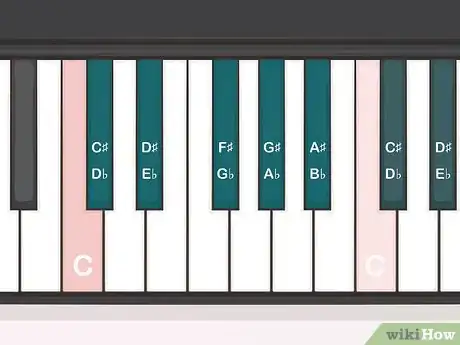

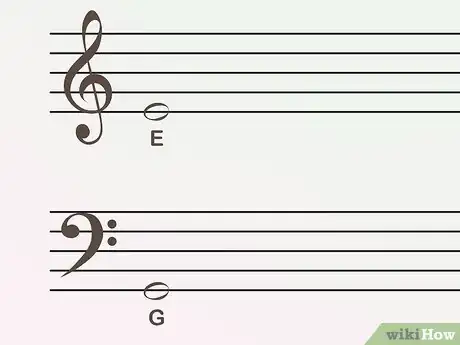
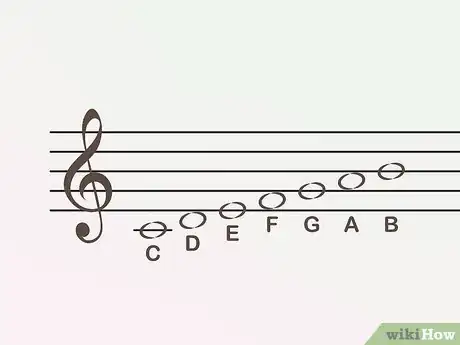

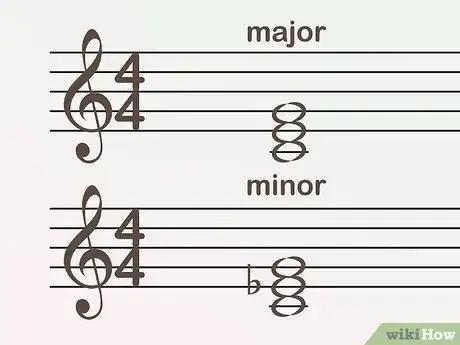
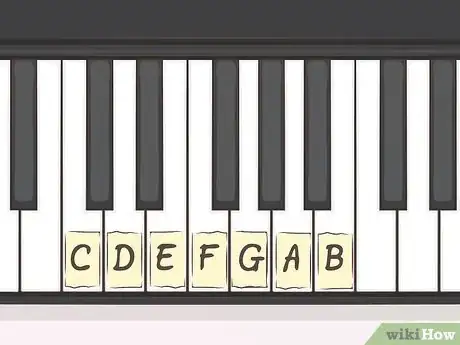
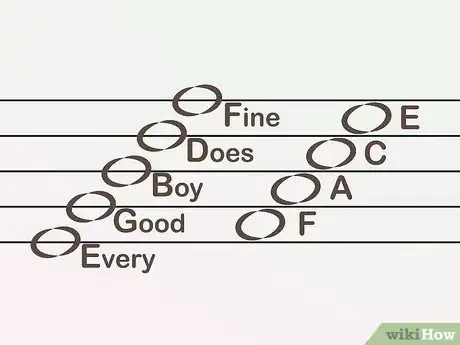

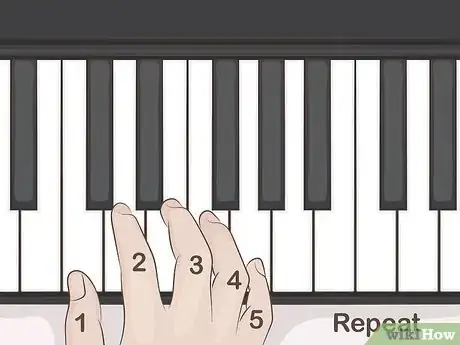

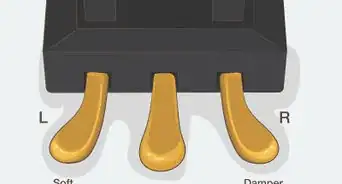


-Step-17-Version-4.webp)


